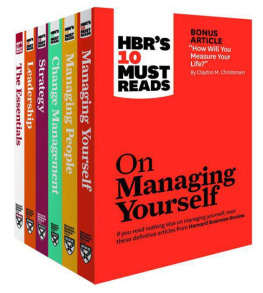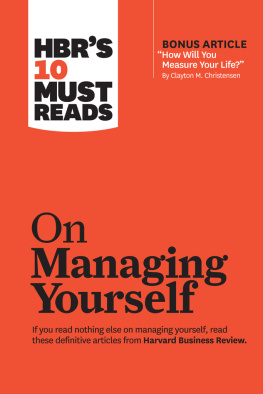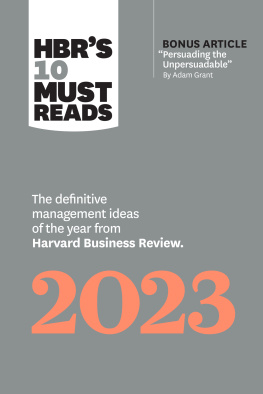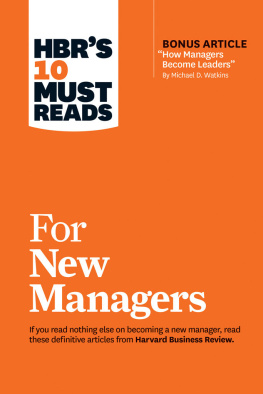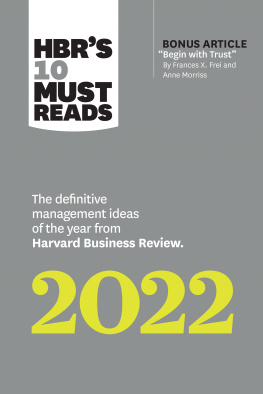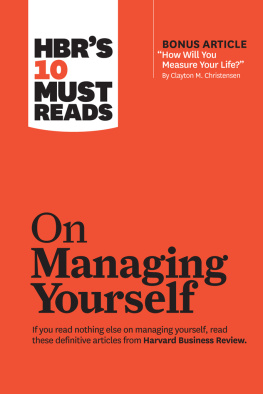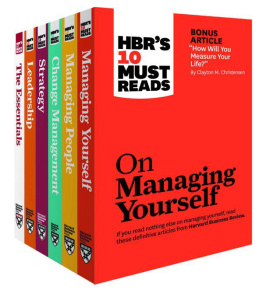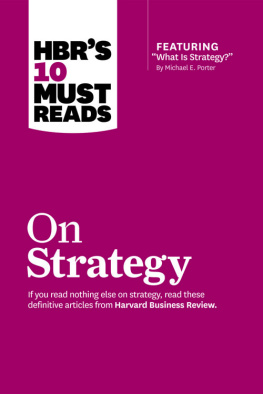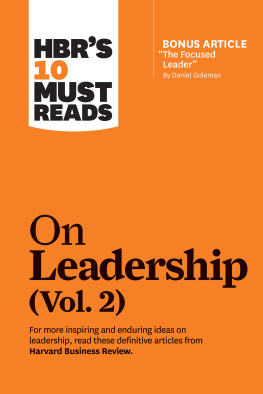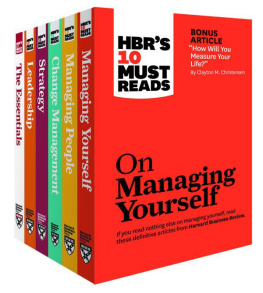Harvard Business Review - HBRs Must Reads Boxed Set
Here you can read online Harvard Business Review - HBRs Must Reads Boxed Set full text of the book (entire story) in english for free. Download pdf and epub, get meaning, cover and reviews about this ebook. year: 2011, publisher: Harvard Business Review Press, genre: Business. Description of the work, (preface) as well as reviews are available. Best literature library LitArk.com created for fans of good reading and offers a wide selection of genres:
Romance novel
Science fiction
Adventure
Detective
Science
History
Home and family
Prose
Art
Politics
Computer
Non-fiction
Religion
Business
Children
Humor
Choose a favorite category and find really read worthwhile books. Enjoy immersion in the world of imagination, feel the emotions of the characters or learn something new for yourself, make an fascinating discovery.
- Book:HBRs Must Reads Boxed Set
- Author:
- Publisher:Harvard Business Review Press
- Genre:
- Year:2011
- Rating:5 / 5
- Favourites:Add to favourites
- Your mark:
HBRs Must Reads Boxed Set: summary, description and annotation
We offer to read an annotation, description, summary or preface (depends on what the author of the book "HBRs Must Reads Boxed Set" wrote himself). If you haven't found the necessary information about the book — write in the comments, we will try to find it.
This six-title collection includes only the most critical articles from the worlds top management experts, curated from Harvard Business Reviews rich archives. Weve done the work of selecting them so you wont have to. From leadership and strategy to managing yourself and others, HBRs Must Reads offer foundational articles on essential business topics to help you maximize your organizations performance and your own.
The series includes:
HBRs 10 Must Reads: The Essentials
This book brings together the best thinking from managements most influential experts. Arm yourself with the insights of Michael Porter on competitive advantage, John Kotter on leading change, Daniel Goleman on emotional intelligence, Peter Drucker on managing your career, Clayton Christensen on disruptive innovation, Tom Davenport on analytics, Robert Kaplan and David Norton on measuring strategy with the balanced scorecard, Rosabeth Moss Kanter on innovation, Ted Levitt on marketing, and C.K. Prahalad and Gary Hamel on core competence. Once youve read these definitive articles, you can delve into each core topic the series explores: managing yourself, managing people, leadership, strategy, and change management.
HBRs 10 Must Reads on Managing Yourself
The path to your professional success starts with a critical look in the mirror. Heres how to stay engaged throughout your 50-year work life, tap into your deepest values, solicit candid feedback, replenish your physical and mental energy, and rebound from tough times. This book includes the bonus article How Will You Measure Your Life? by Clayton M. Christensen.
HBRs 10 Must Reads on Managing People
Managing your employees is fraught with challenges, even if youre a seasoned pro. Boost their performance by tailoring your management styles to their temperaments, motivating with responsibility rather than money, fostering trust through solicited input, giving rookie managers the support they need, and building high-performing teams.
HBRs 10 Must Reads on Leadership
Are you an extraordinary leaderor just a good manager? Learn how to motivate others to excel, build your teams confidence, set direction, encourage smart risk-taking, credit others for your success, and draw strength from adversity.
HBRs 10 Must Reads on Strategy
Is your company spending too much time on strategy development, with too little to show for it? Discover what it takes to distinguish your company from rivals, clarify what it will (and wont) do, create blue oceans of uncontested market space, and make your priorities explicit so employees can realize your vision.
HBRs 10 Must Reads on Change Management
Most companies change initiatives failbut yours can beat the odds. Learn how to overcome addiction to the status quo, establish a sense of urgency, mobilize commitment and resources, silence naysayers, minimize the pain of change, and motivate change even when business is good.
Harvard Business Review: author's other books
Who wrote HBRs Must Reads Boxed Set? Find out the surname, the name of the author of the book and a list of all author's works by series.

